Rainforest Garden
The Rainforest Garden at the Creation Museum is an area replete with tropical plants. You will see the large leaves of banana trees, elephant ears and more! See if you can find the large T. rex topiary hidden in this garden.
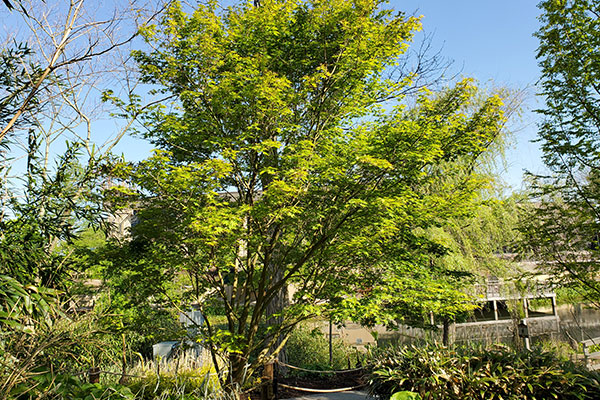
Japanese Maple
Common Name: Japanese Maple
Botanical Name: Acer palmatum
Height: 10–30 feet
Spread: 10–25 feet
Location: Full sun to part shade
Bloom: April, reddish-purple
Hardiness zone 5–8
There are many varieties of Japanese maple with one of the hardiest being Acer palmatum. The smaller size leaves emerge a bright green turning darker green during the growing season. They then turn a fabulous orange-red color for the fall with the color varying depending on the amount of sunlight they receive. The growing habit of the tree is upright with a domed canopy supported by bright green trunk giving year-round appeal.

Variegated Sweet Flag
Common Name: Variegated Sweet Flag
Botanical Name: Acorus calamus variegatus
Height: 2–23 feet
Spread: 1.5–2 feet
Location: Full sun to part shade
Bloom: Late spring, green flower, not showy
Hardiness zone 5–11
Variegated Sweet Flag is very easy to grow but can become invasive in boggy soil conditions. When placing in the landscape, the variegated leaf stands tall and makes a great contrast or accent plant in a water garden or any area with an adequate water supply. The name “Sweet Flag” derives from the practice of hanging the leaf “flag” and bruising it which causes it to expel a sweet aroma. Calamus is mentioned in the Bible in Ezekiel 27:19 and a few other places as well.

Mimosa Silk Tree
Common Name: Mimosa Silk Tree
Botanical Name: Albizia julibrissin
Height: 20–40 feet
Spread: 20–50 feet
Location: Full sun to part shade
Bloom: June – July, pink flower
Hardiness zone 6–10
Mimosa trees are normally vase shaped and multi-stemmed growing a somewhat flat top crown. They have a tropical look with the long compound leaves each having many little leaflets giving them a fern look on a grand scale. They produce a fluffy pink flower that covers the tree with summer long blooms loved by bees and hummingbirds. Long, flat bean-pod like seeds follow the flowers and persist into the winter. The leaves are very frost sensitive and usual drop on or near the first frost giving no fall color change. This tree is considered invasive in some areas. Seed pod cleanup will help you control the unwanted seedlings that can occur in your garden.

Voodoo Lily
Common Name: Voodoo Lily
Botanical Name: Amorphophallus konjac
Height: 4–6 feet
Spread: 2–4 feet
Location: Full sun to part shade
Bloom: purple, with a strong temporary odor
Hardiness zone 6–10
Voodoo Lily can produce a very interesting vase shaped flower from each bulb in spring before the leaves emerge. The flower size increases as the bulb matures and increases in size. It also produces an odor described as a dead animal, but it does not last long, thankfully. The fleshy leaf stalk is mottled pinkish grey and olive green each consisting of a single, intricate leaf with three sections giving an umbrella affect. The Konjac roots, or tubers are edible and are grown as a food source in some parts of the world. They can be used as a gelatin in flour, noodles, or even fruit jelly snacks.

Variegated Japanese Angelica Tree
Common Name: Variegated Japanese Angelica Tree
Botanical Name: Aralia elata
Height: 12–15 feet
Spread: 6–10 feet
Location: Full sun to part shade
Bloom: July – August, white flower
Hardiness zone 4–9
The Angelica tree in our Rainforest is a visual stunner! In nature these are most commonly in shrub form, but you can find single stem tree forms occasionally in commerce. Our variegated variety has a creamy white boarder along the edge of each leaflet. The flower blooms are up to 18-inch-long panicles of small white petals creating a lacy veil that covers the canopy. Care needs to be taken when choosing a location in your garden due to the sticker like spines that cover the branches and stem. This plant also shoots off new growth around the base that will need to be pruned to maintain the tree form.
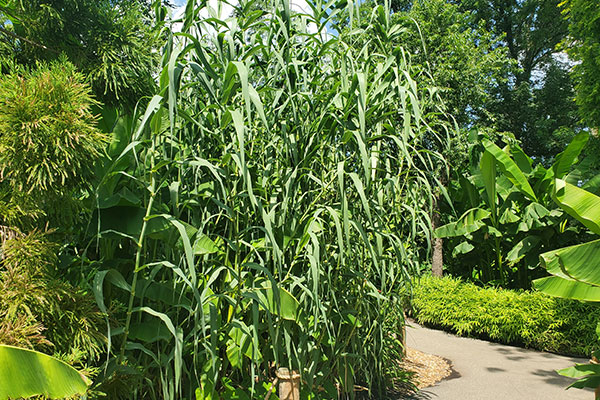
Giant Reed Grass
Common Name: Giant Reed Grass
Botanical Name: Arundo donax
Height: 12–20 feet
Spread: 5–8 feet
Location: Full sun to part shade
Bloom: September – October, purple plume
Hardiness zone 6–11
Giant Reed grass is a perennial plant in our 6a zone but can still grow to 20 feet tall in one season. It is often thought to be something else due to its size and overall characteristics, but it is a reed in the grass family. The leaves are sword like and greyish green in color. The purple, feather like seed plume develops later in the season and usually holds until the first frost. Fun fact, the reeds in woodwind musical instruments are made from the stems of this plant. This is also a rhizomatous plant so the roots can spread underground to unwanted areas if not controlled. Some areas consider this invasive so care should be taken when choosing a location in your garden.

Wild Ginger
Common Name: Wild Ginger
Botanical Name: Asarum canadense
Height: .5–1 foot
Spread: 1–1.5 feet
Location: Full sun to part shade
Bloom: April – May, purplish brown
Hardiness zone 4–6
Wild Ginger has heart-shaped leaves and a dense root system that can form a solid ground cover in a shady area. Each individual plant has two leaves and a spring flower that emerges at the point where the two leaf stems meet close to the ground which often blocks the flowers view. Although this is not culinary ginger, the roots produce a similar scent and can be used as a ginger substitute. No serious disease or insect problems are noted.
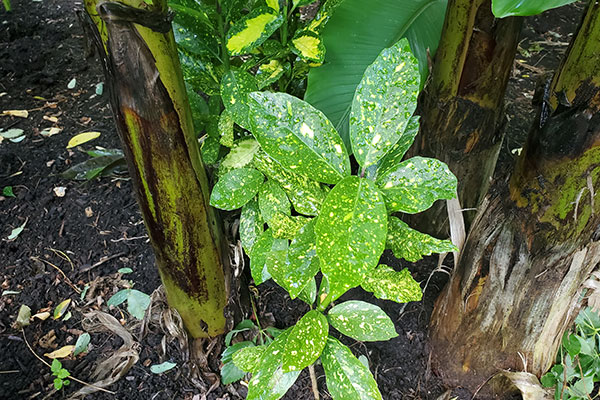
Gold Dust Japanese Laurel
Common Name: Gold Dust Japanese Laurel
Botanical Name: Aucuba japonica variegate
Height: 6–10 feet
Spread: 4–6 feet
Location: Full sun to part shade
Bloom: March – April, purple maroon
Hardiness zone 7–10
Gold Dust has fantastically variegated leaves with gold spots throughout the leaf surface. They are shiny, dark green, and a narrow oval shape. This is a small shrub for us but can grow much larger in warmer climates. The Creation Museum is north of the typical planting zone range for this plant, so care is taken to help them overwinter with a good root mulching. In addition, they are planted in a protected area from wind and direct sun which they do not like. It does appear that the variegated varieties of Aucuba, like ours, are somewhat hardier than others which also helps with their survival.
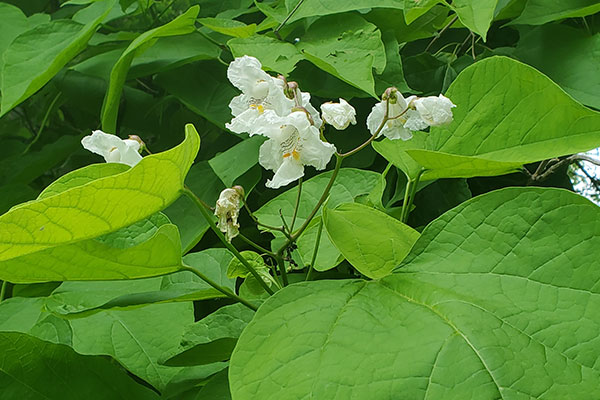
Northern Catalpa Tree
Common Name: Northern Catalpa Tree
Botanical Name: Catalpa speciosa
Height: 40–60 feet
Spread: 20–40 feet
Location: Full sun to part shade
Bloom: May – June, white with purple stripes and yellow splotches
Hardiness zone 4–8
The Northern Catalpa has large, up to 12” oval, almost heart shaped leaves that are an easy identifier for this tree. They emerge in the spring a light green and hold that color through the season turning yellow in the fall. The showy, orchid-like flowers growing in large panicles are a real showstopper. Following the flowers are long, slender green seedpods that mature to a dark brown in the fall. The seedpods dry, then split open releasing the seeds helping this plant to naturalize an area if not controlled.

Eastern Redbud
Common Name: Eastern Redbud
Botanical Name: Cercis canadensis
Height: 20–30 feet
Spread: 25–35 feet
Location: Full sun to part shade
Bloom: April, pink flower
Hardiness zone 4–9
There are many hybrid Redbud trees all having unique characteristics. The standard Eastern Redbud that you see in tree lines, fence rows, and in the woodlands of the eastern U.S. still stands as a remarkably attractive native tree and is still available in commerce. It is very adaptable to a variety of conditions and consistently produces the pink flowers seen for miles in early spring before the leaves emerge making it a carefree choice for most gardens.
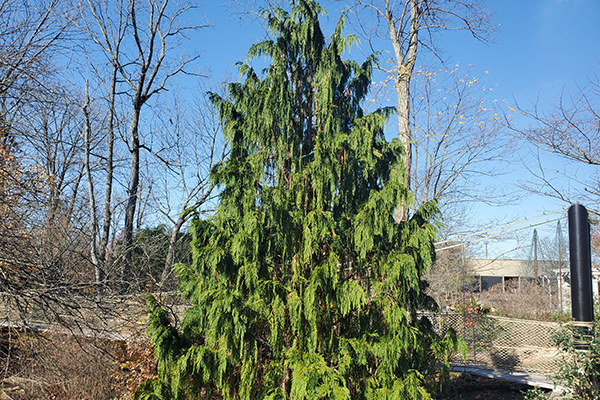
Weeping Alaskan Cedar
Common Name: Weeping Alaskan Cedar
Botanical Name: Chamaecyparis nootkatensis pendula
Height: 20–35 feet
Spread: 8–12 feet
Location: Full sun to part shade
Bloom: non-flowering
Hardiness zone 4–7
This North American evergreen conifer with beautiful shredding and ridged bark is well adapted to most gardens. It could be used as an individual specimen, or in a grouping for a larger area. This weeping cedar is a great example of why we need to know the scientific name of the plants that we care for. One could easily consider this in the cedar family from the common name which it is not.
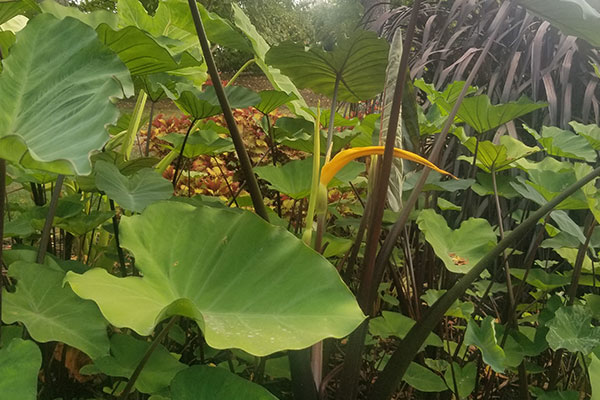
Big Dipper Elephant Ear
Common Name: Big Dipper Elephant Ear
Botanical Name: Colocasia esculenta
Height: 3–7 feet
Spread: 3–6 feet
Location: Full sun to part shade
Bloom: June, yellowish white
Hardiness zone 8–11
Big Dipper has tall, purple-black stems that hold a large grey-green leaf horizontally before they mature. This unique effect allows the leaf to hold quite a lot of water. When it is full, it dumps the water then stands back horizontal to catch more. Fascinating! This elephant ear also spreads with snake like tubers that run above ground adding another interesting feature. This variety is more difficult to overwinter outside in our 6a plant zone, so we usually collect some of the tubers and pot them for the next season.
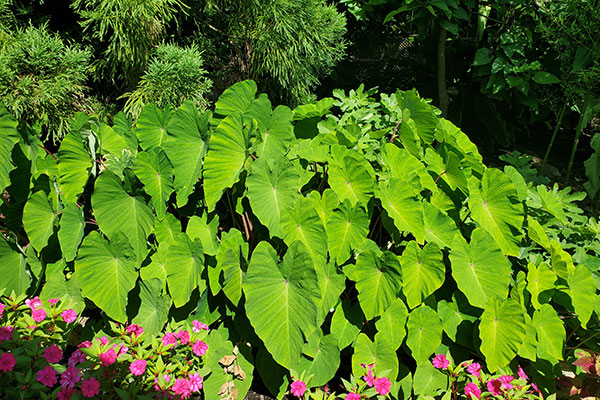
Pink China Elephant Ear
Common Name: Pink China Elephant Ear
Botanical Name: Colocasia esculenta
Height: 4–6 feet
Spread: 4–6 feet
Location: Full sun to part shade
Bloom: June, yellowish white
Hardiness zone 6–11
This hybrid variety of elephant ear has bright pink stems and medium green leaves with a pink dot in the center of the leaf adding tropical color to any garden. This may be the cold hardiest variety of elephant ear available in commerce. Pink China can and does tolerate our zone 6a plant zone with a layer of mulch as a winter protection. This is an easy to care for tropical plant for colder areas that increases in size via rhizomes. Warmer climates may need to use control methods to limit the increase in plant size.
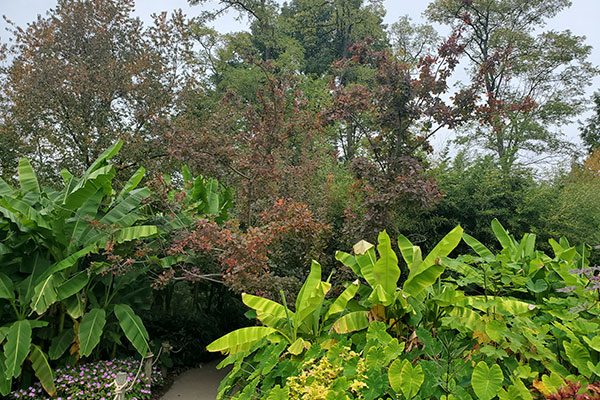
Grace Purple Smoketree
Common Name: Grace Purple Smoketree
Botanical Name: Cotinus coggygria
Height: 12–15 feet
Spread: 12–15 feet
Location: Full sun
Bloom: May – June, yellow
Hardiness zone 4–9
Grace is an award winning, newer variety of smoketree noted for its attractive foliage. The rounded leaves emerge a bright red in spring maturing to a dark red for the summer before turning a range of red to yellow for the fall season. Large pink flower panicles cover the tree in early summer giving a smoke-like appearance which is where the name comes from. The best leaf coloration happens in full sun although part shade is tolerated. Pruning back in late winter or early spring will promote new shoots and enhance the purple color while also controlling the size although some flowering will be lost if you do prune.
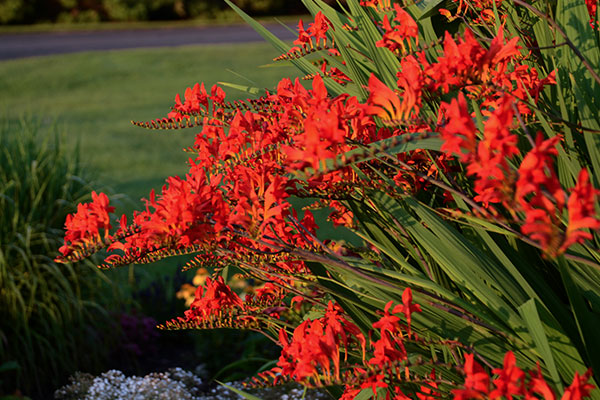
Lucifer Montbretia
Common Name: Lucifer Montbretia
Botanical Name: Crocosmia curtonus
Height: 2–4 feet
Spread: 1–2 feet
Location: Full sun to part shade
Bloom: June, red
Hardiness zone 5–10
One of the most popular varieties of Crocosmia, Lucifer produces vertical clumps of pleated, sword like leaves providing an interesting vertical accent to your garden. The scarlet red tubular flowers arrive in mid-summer and hold for up to 8 weeks attracting hummingbirds and butterflies. They are vibrant! Following the flowers, the plant produces seedpods that provide a food source for hungry birds in the winter.
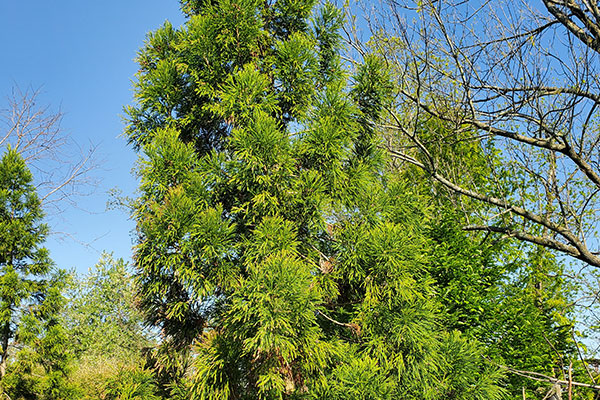
Japanese Cedar
Common Name: Japanese Cedar
Botanical Name: Cryptomeria japoica
Height: 50–70 feet
Spread: 20–30 feet
Location: Full sun
Bloom: Non-flowering
Hardiness zone 5–9
Japanese Cedar is a soft needled evergreen and is a prized timer tree in its native habitat of Japan and China. Even though this is not in the ‘Cedrus” or Cedar family, it does have some similar characteristics. For instance, the bark is reddish brown and peels off in long strips while the needles also look similar. The foliage may turn a bronze color in cold winters but will return to green in the summer sun. This is commonly used as an accent plant at the entry to prominent buildings in Japan but can also be used in a large or small grouping.
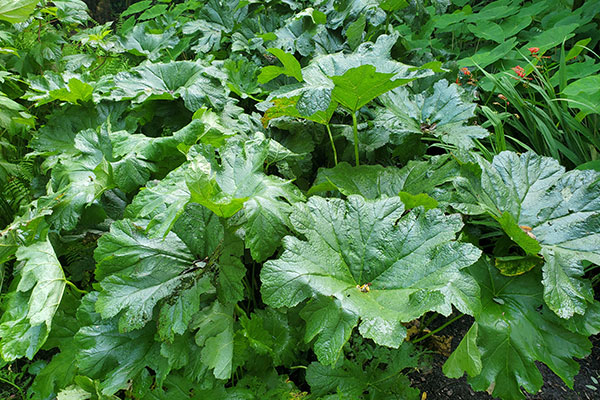
Umbrella Plant
Common Name: Umbrella Plant
Botanical Name: Darmera peltata
Height: 3–8 feet
Spread: 3–5 feet
Location: Part shade to full shade
Bloom: April, pink to white
Hardiness zone 5–9
Umbrella plant is a rhizomatous perennial that grows up to 5 feet tall with large glossy leaves that can be 18 inches across. Dramatic for any garden! They are native to the mountain streams banks in Oregon to northern California. Interestingly, the clusters of pale pink to white flowers appear before the foliage in the spring on top of tall bare stems. This plant can survive in the sun with plenty of care but prefers some shade.
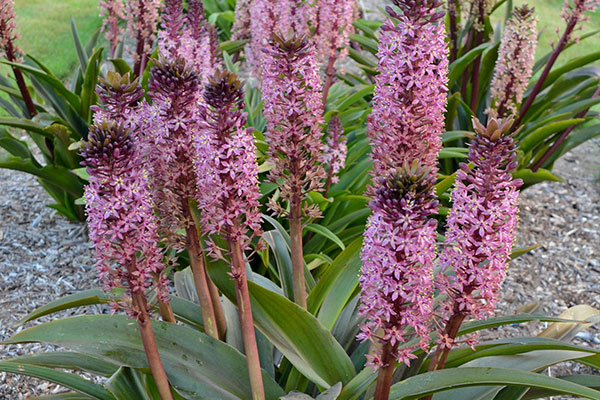
Sparkling Burgundy Pineapple Lily
Common Name: Sparkling Burgundy Pineapple Lily
Botanical Name: Eucomis comosac
Height: 2–3 feet
Spread: 1.5–3 feet
Location: Full sun to part shade
Bloom: July to August, white - purple
Hardiness zone 7–10
Pineapple Lily is an award winner growing up to 3 feet tall with purple spotted, dark green leaves. A purple flower stalk rises in mid to late summer producing a mass of tiny star shaped white to purple flowers lasting up to 8 weeks. The mass of flowers is shaped like a pineapple, hence the name. Typically, in a 6a zone like we have at the Creation Museum, you would either plant these in a pot, or pull them from the ground and bring them indoors during the winter. We add layers of mulch to help ours survive outside through the winter; they also have some wind protection from other plants.
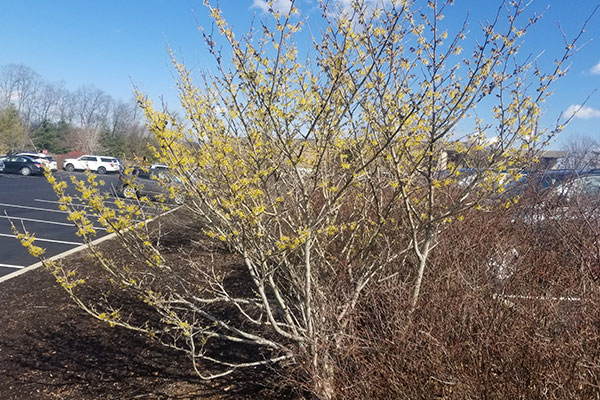
Vernal Witch Hazel
Common Name: Vernal Witch Hazel
Botanical Name: Hamamelis vernalis
Height: 6–16.5 feet
Spread: 8–15 feet
Location: Full sun to part shade
Bloom: January to April, yellow flower
Hardiness zone 3–8
Witch Hazel is a prized winter garden plant that has a fragrant bloom time starting in January to early February for us. It is a usually a welcome sign that winter is coming to an end. Easy to grow, best suited in a woodland garden or as a screen or hedge. We have several of them under the swinging bridge where they have some freedom to grow. The leaves turn a golden yellow in the fall, which is also a good time to prune, as needed.
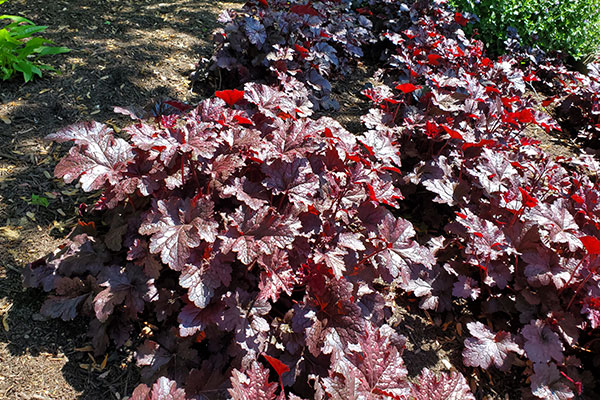
Palace Purple Coral Bells
Common Name: Palace Purple Coral Bells
Botanical Name: Heuchera micrantha diversifolia
Height: 1–2 feet
Spread: 1–2 feet
Location: Full sun to part shade
Bloom: June to July, white flower
Hardiness zone 4–9
The very large, purple/bronze star-shaped leaf is one characteristic that makes this award winner in the Heuchera family very popular with many gardeners. This is a perennial plant so it will come back for you every year. It is easy to grow and requires little maintenance. It will look great along a border, in your rock garden, or in a planter. In late spring, there are groups of small, bell-shaped, white flowers on 20” high stems that give great contrast to the foliage.

Empress Wu Hosta
Common Name: Empress Wu Hosta
Botanical Name: Hosta
Height: 4–5 feet
Spread: 6–8 feet
Location: Part shade to full shade
Bloom: July to August, lavender
Hardiness zone 3–9
Empress Wu is among the largest, if not the largest overall size Hosta that is available in commerce today. If given the correct environment and nutrients, they could reach 5 feet tall! The dark blue, deeply veined leaves grow into an upright, cascading mound that is quite impressive. Pale lavender flowers appear in early summer just above the foliage. Natively, these are found in woodland settings, so they prefer shade. The name was chosen to honor the only female in history to be the emperor of China.

Krossa Regal Hosta
Common Name: Krossa Regal Hosta
Botanical Name: Hosta
Height: 3–6 feet
Spread: 3–6 feet
Location: Part shade to full shade
Bloom: July to August, lavender
Hardiness zone 3–8
Krossa is typically a larger Hosta variety grown best in shady areas. One interesting characteristic is the vase shape that Krossa grows in rather than the more usual mounded growing habit. The blue green to grayish leaves are smooth, widely veined, and have wide wavy margins. The lavender flowers arrive in mid to late summer and stand well above the foliage and can rise to 6 feet. Excellent foliage for that shady area in your garden.
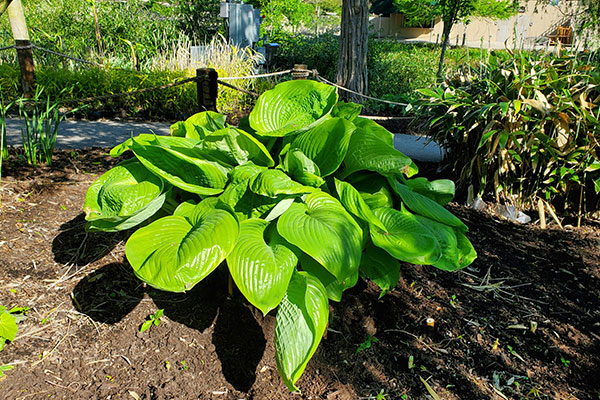
Sum and Substance Hosta
Common Name: Sum and Substance Hosta
Botanical Name: Hosta
Height: 2–3 feet
Spread: 3–6 feet
Location: Full sun to part shade
Bloom: August, lavender
Hardiness zone 3–9
Sum and Substance is a large variety Hosta with beautiful heart shaped leaves that are a glossy, golden green color. To achieve that color, this unusual variety needs a little more sunlight than most others. Bell shaped, fragrant lavender flowers appear in summer rising to 4 feet tall well above the foliage. This variety is easily grown in well-drained soil and are thought to be resistant to slugs due to their waxy leaves, normal inspection is recommended.

Climbing Hydrangea
Common Name: Climbing Hydrangea
Botanical Name: Hydrangea anomala subsp. petiolaris
Height: 30–50 feet
Spread: 5–6 feet
Location: Part shade to full shade
Bloom: May to July, white
Hardiness zone 4–9
Climbing Hydrangea is woody vine that grows vigorously and is quite often mis-identified in our Rainforest garden. This sprawling, deciduous vine clings and climbs walls, arbors, or tree trunks up to 50 feet tall. The dark green, oval shaped leaves appear in the spring followed by white clusters of fragrant flowers in May. Once established, this vine can become somewhat bushy growing out several feet from the support structure which is unusual for a climbing vine.
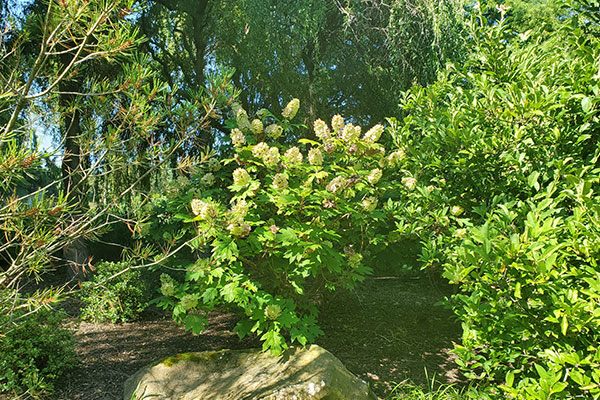
Snow Queen Oakleaf Hydrangea
Common Name: Snow Queen Oakleaf Hydrangea
Botanical Name: Hydrangea quercifolia
Height: 4–6 feet
Spread: 6–8 feet
Location: Full sun to part shade
Bloom: May to June, white
Hardiness zone 5–9
Snow Queen is a densely upright shrub with a rounded growing habit that typically reaches 6 feet tall. Noted for its boldly lobed, oak shaped leaves and its more abundant showy blooms, this award winner will give your garden interest in every season. This one blooms on last year’s growth so, if desired, it should be pruned after the flowering is complete.
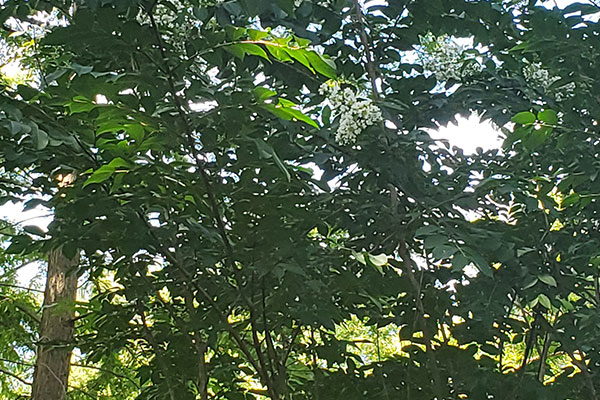
Natchez Crapemyrtle
Common Name: Natchez Crapemyrtle
Botanical Name: Lagerstroemia indica fauriei
Height: 20–30 feet
Spread: 15–20 feet
Location: Full sun
Bloom: July to September, white
Hardiness zone 6–10
Natchez, named after a Native American tribe, is a mildew resistant hybrid developed by the National Arboretum. It is normally an upright, vase shaped shrub although it can be trained to be a single stem tree. The leaves are oval shaped and dark green. It has a profusion of white flower clusters in midsummer followed by round seed capsules that persist into winter. Ours at the Creation Museum may die to the ground during a cold winter but the roots survive and produce new shoots for the growing season.

Variegated Lilyturf
Common Name: Variegated Lilyturf
Botanical Name: Liriope muscari variegata
Height: 1–1.5 feet
Spread: 1–3 feet
Location: Full sun to part shade
Bloom: August, Purple flower
Hardiness zone 5–10
We love Liriope as a border plant, but we also use it in groupings throughout the Botanical Gardens. Be careful to read the growth habits for your liriope before planting. Our variegated variety “Muscari Variegate” grows in clumps increasing in size every year. Our solid green variety, “Big Blue” is a ground-covering plant and will take over an area that you may not want. They look very similar in the pot when you purchase so we suggest reading before planting as with all plants. Both our types of Liriope have violet – purple flowers although some white varieties are available. They bloom in late summer giving way to black berries that persist into the winter. They are perennials so we cut them back, but we wait until late in the winter since the foliage holds its color. They return in the spring with new growth ready for another growing season.

Gold Rush Dawn Redwood
Common Name: Gold Rush Dawn Redwood
Botanical Name: Metasequoia glyptostroboides
Height: 70–100 feet
Spread: 15–30 feet
Location: Full sun
Bloom: non-flowering
Hardiness zone 4–10
Dawn Redwood was once thought to be extinct until 1944 when it was discovered growing in central China. It is closely related to the bald cypress and the very large sequoia redwoods. It is a fast growing, deciduous tree that is also a conifer, in other words, it drops its “leaves” that look like needles in the fall and it produces cones like many other evergreens. The needles are softer than most evergreens and they turn a rust color in the fall before dropping to expose the beautiful, fluted trunk with somewhat shaggy bark. Gold Rush is a cultivar with bright, golden yellow leaves that thrive in the sun and make this one a great choice for your garden.

Japanese Fiber Banana
Common Name: Japanese Fiber Banana
Botanical Name: Musa basjoo
Height: 6–18 feet
Spread: 6–12 feet
Location: Full sun
Bloom: Summer, yellowish
Hardiness zone 5–10
A Banana in Kentucky? Yes! The roots are cold hardy to zone 5, but not the pseudo stem or leaves. The plant stops growing at 40 degrees and dies to the ground on the first frost. At this point you have options on how to help the plant survive over the winter. We cut ours back and put 2 to 3 feet of mulch on each one, the mulch must be removed by hand in the spring. Each banana requires a consistent amount of moisture while growing you can also fertilize to obtain the maximum growth for the season. They do occasionally flower although our summer season is not long enough for them to produce bananas. You can grow these in your garden and add a warm tropical feel that will fascinate all your friends.
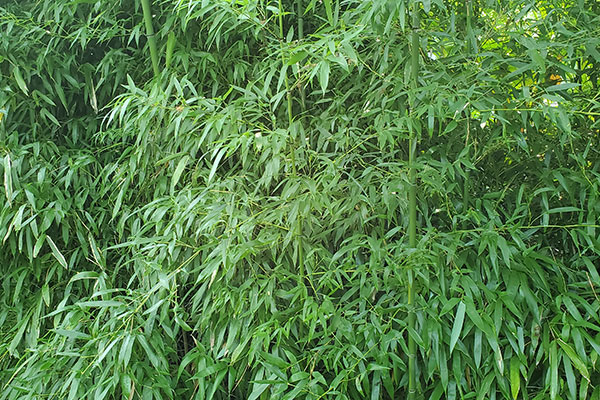
Yellow Groove Bamboo
Common Name: Yellow Groove Bamboo
Botanical Name: Phyllostachys aureosulcata
Height: 12–40 feet
Spread: 12–25 feet or more if not controlled
Location: Full sun
Bloom: rarely flowers
Hardiness zone 4–10
As an ornamental, Yellow Grove is one of the most widely planted varieties of bamboos introduced into the U.S. in the early 1900’s. It is cold hardy and almost an evergreen with dark green culms and a yellow groove (sulcis) growing vertically on the side making it very identifiable. The leaves are also a dark olive-green color and grow to 7-inch-long. This is a great plant to use as a screen, hedge, or background for your garden. It spreads by rhizomes and will spread into unwanted areas unless a barrier or other control methods is used.
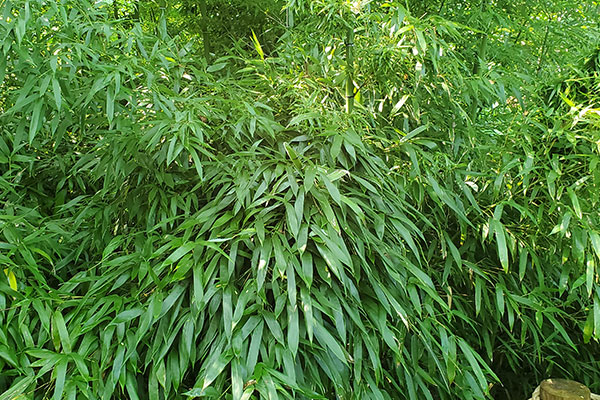
Japanese Bamboo
Common Name: Japanese Bamboo
Botanical Name: Sasa tsuboiana
Height: 4–6 feet
Spread: 4–5 feet
Location: Part sun to part shade
Bloom: non-flowering
Hardiness zone 5–10
This Sasa has distinctively dark green, glossy leaves that grow up to 11 inches long and is considered one of the most attractive varieties. It is also considered a deer resistant ground cover that can serve as a barrier in your garden and is quite cold hardy surviving to a negative 20 degrees. It is very easy to care for although beware that it is rhizomatous so it will spread to unwanted areas if control methods are not used.